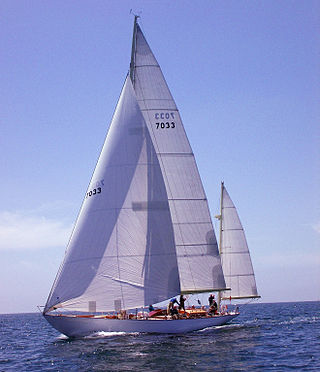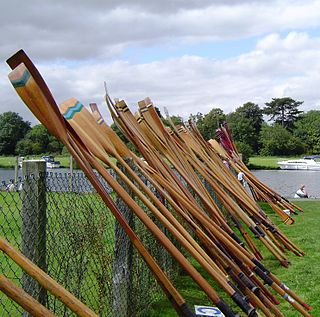
Rowing, sometimes called crew in the United States, is the sport of racing boats using oars. It differs from paddling sports in that rowing oars are attached to the boat using oarlocks, while paddles are not connected to the boat. Rowing is divided into two disciplines: sculling and sweep rowing. In sculling, each rower holds two oars, one in each hand, while in sweep rowing each rower holds one oar with both hands. There are several boat classes in which athletes may compete, ranging from single sculls, occupied by one person, to shells with eight rowers and a coxswain, called eights. There are a wide variety of course types and formats of racing, but most elite and championship level racing is conducted on calm water courses 2 kilometres (1.2 mi) long with several lanes marked using buoys.

A dinghy is a type of small boat, often carried or towed by a larger vessel for use as a tender. Utility dinghies are usually rowboats or have an outboard motor. Some are rigged for sailing but they differ from sailing dinghies, which are designed first and foremost for sailing. A dinghy's main use is for transfers from larger boats, especially when the larger boat cannot dock at a suitably-sized port or marina.

A yawl is a type of boat. The term has several meanings. It can apply to the rig, to the hull type or to the use which the vessel is put.

An oar is an implement used for water-borne propulsion. Oars have a flat blade at one end. Rowers grasp the oar at the other end.
The Mirror is a type of popular sailing dinghy with more than 70,000 built.

The Sea Cadet Corps is a national youth charity. It is present in England, Scotland, Wales, Northern Ireland, Malta and Bermuda. Cadets follow an ethos, training plan and rank structure similar to that of the Royal Navy, and are recognised by the UK Ministry of Defence.

Rowing is the act of propelling a human-powered watercraft using the sweeping motions of oars to displace water and generate reactional propulsion. Rowing is functionally similar to paddling, but rowing requires oars to be mechanically attached to the boat, and the rower drives the oar like a lever, exerting force in the same direction as the boat's travel; while paddles are completely hand-held and have no attachment to the boat, and are driven like a cantilever, exerting force opposite to the intended direction of the boat.
In competitive rowing, the following specialized terms are important in the corresponding aspects of the sport:
A skiff is any of a variety of essentially unrelated styles of small boats, usually propelled by sails or oars. Traditionally, these are coastal craft or river craft used for work, leisure, as a utility craft, and for fishing, and have a one-person or small crew. Sailing skiffs have developed into high performance competitive classes. Many of today's skiff classes are based in Australia and New Zealand in the form of 12 ft (3.66 m), 13 ft (3.96 m), 16 ft (4.88 m) and 18 ft (5.49 m) skiffs. The 29er, 49er, SKUD and Musto Skiff are all considered to have developed from the skiff concept, all of which are sailed internationally.

The Moth is a small development class of sailing dinghy. Originally a small, fast home-built sailing boat designed to plane, since 2000 it has become an expensive and largely commercially produced boat designed to hydroplane on foils though many are still built at home, typically at much lower cost.

In rowing, oars are used to propel the boat. Oars differ from paddles in that they use a fixed or sliding fulcrum, an oarlock or rowlock attached to the side of the boat, to transfer power from the handle to the blade, rather than using the athlete's shoulders or hands as the pivot-point as in canoeing and kayaking.
Ian Douglas Ben Proctor was a British designer of boats, both sailing dinghies and cruisers. He had more than one hundred designs to his credit, from which an estimate of at least 65,000 boats were built. His pioneering aluminium mast designs also revolutionised the sport of sailing.

Skiffing refers to the sporting and leisure activity of rowing a Thames skiff. The skiff is a traditional hand built clinker-built wooden craft of a design which has been seen on the River Thames and other waterways in England and other countries since the 19th century. Sculling is the act of propelling the boat with a pair of oars, as opposed to rowing which requires both hands on a single oar.
The Thames is one of the main rowing rivers in Europe. Several annual competitions are held along its course, including the Henley Royal Regatta, The Boat Race and other long-distance events, called Head of the River races (Heads).

A thwart is a part of an undecked boat that provides seats for the crew and structural rigidity for the hull. A thwart goes from one side of the hull to the other. There may be just one thwart in a small boat, or many in a larger boat, especially if several oarsmen need to be accommodated.

Human-powered watercraft are watercraft propelled only by human power, instead of being propelled by wind power or an engine.
The following outline is provided as an overview of and topical guide to sailing:
The Tech Dinghy is an American sailing dinghy that was designed by George Owen, a professor at Massachusetts Institute of Technology (MIT), as a one-design racer and for sail training. It was first built in 1935.
G. Prout and Sons of Canvey Island, Essex, in the United Kingdom, was initially a builder of folding dinghies, canoes and kayaks founded in 1935. In the 1950s, the company moved to the construction of small sailing catamarans with Shearwater I and later Shearwater III, which the National Maritime Museum describes as the first production catamaran in the world. The company then developed from small catamarans to larger cruising vessels. G. Prout & Sons was dissolved in 2002.
This glossary of nautical terms is an alphabetical listing of terms and expressions connected with ships, shipping, seamanship and navigation on water. Some remain current, while many date from the 17th to 19th centuries. The word nautical derives from the Latin nauticus, from Greek nautikos, from nautēs: "sailor", from naus: "ship".










